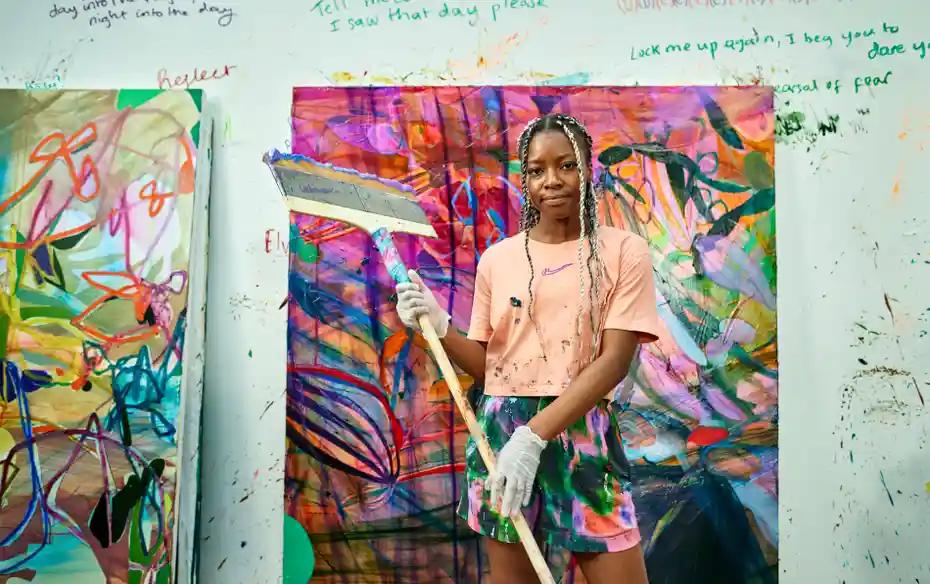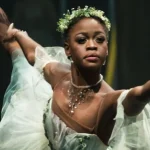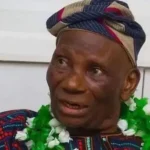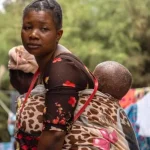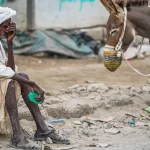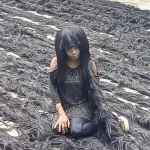She’s only 29 yet her paintings have already been scooped up by the Tate and fetched over £1m at auction. Now she’s thinking even bigger. On the eve of a new exhibition, the artist talks colour visions and anime obsessions
Acorrugated metal door rattles open and Jadé Fadojutimi appears. She welcomes me inside, as the sun beats down on the south London industrial estate where she keeps a studio. An extremely stylish dresser, who often poses on Instagram in an outfit coordinated with her paintings, the artist is today wearing a neon yellow top and multicoloured shorts, with her nails painted green, red and teal – all part of her oeuvre, she explains, since “anything that creates a composition is a painting”. Spirit, an ambient album by Atom Music Audio, booms from the speakers. Two rococo settees sit either side of a table bearing a bottle of sake, surrounded by an extravagant display of pot plants. And propped against the walls are her enormous, immersive, gloriously colourful new paintings, destined for Hepworth Wakefield in Yorkshire this month.
The show, she explains, is called Can We See the Colour Green Because We Have a Name For It? The title was inspired by a book by Peter Wohlleben called The Heartbeat of Trees, “about our senses and relationships to colour and how where you grow up kind of determines the colours you can see and your colour sensitivity”. Fadojutimi believes she has synaesthesia (although “there’s no test for it”), where other forms of stimulation bring on visions of colour. “I’m not one of those people who reads and then the words change colour, but when I feel emotion, I see a colour and that’s how my paintings come to life.”
These pictures, which exist in a thrilling mid-point between the abstract and the figurative, have made Fadojutimi hot property. Still only 29, she is the youngest artist to have a work collected by the Tate (I Present Your Royal Highness, from 2018), while last October, on consecutive nights, two of her paintings were bought at auction for more than £1m each – one, Myths of Pleasure, went for 15 times its estimate. “I don’t know what it means and I don’t want to know what it means,” Fadojutimi said with a shudder the following month about her work’s rocketing commercial value so early in her career. This year, she became represented by Gagosian, gallery of the billionaire art dealer Larry Gagosian, alongside artists such as Damien Hirst and Takashi Murakami, which seemed to confirm her arrival into art’s superleague.
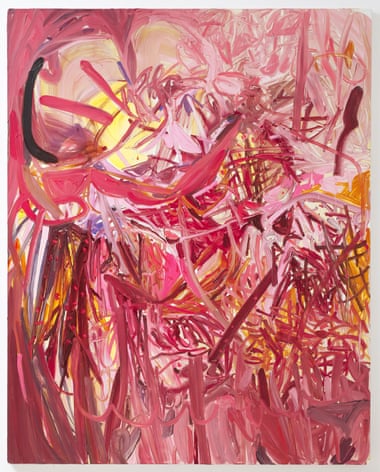
“Is that how these things work? You tell me!” she laughs. “I wanted to be with a gallery that I felt represented my potential, and I also wanted to inspire younger people and not let them feel afraid to be with such a big gallery because why not reach for that higher thing? Especially as a Black woman.”
This sense of ambition is manifested in an enormous, green, paint-splattered, three-panel painting she’s working on when I visit. It will be the centrepiece of the Hepworth show. “When I was in university” – London’s Royal College of Art, from which she graduated in 2017 – “the only thing I wanted to do was make big paintings. I felt limited by every space I’ve had until now.” Happily, she now has a second studio “down the road, which is three times the size of this one”, and is able to “spill on to a surface” in the way that she’s always dreamed of.
For Fadojutimi, painting is intense, both physically and emotionally. Her studio environment – which sometimes includes her childhood soft toys – is arranged so that she can get into the deep state of introspection she needs to paint, thinking about her school and early life, history, or how she feels about what’s happening in the world. Then she dances and runs at the canvas, scales ladders, cries, and sometimes breaks off to write in her diary. The title of the work will often come to her halfway through. She works on her own, through the night, with her favourite soundtracks blasting out, and sometimes she can finish a painting in a single night if she feels gripped. “It becomes a force that just takes over,” she says. “I always want to call it witchcraft.” Then, in the morning, she goes home to bed and her assistants come to get the studio ready so she can start again.
Fadojutimi grew up in Ilford, east London, the eldest of three girls. Her mum is a civil servant, her dad a management consultant. The first artwork she can remember is a Monet print in the family home. She still loves Monet, as well as Cézanne, David Hockney and the American abstract artist Joan Mitchell – all masters of colour. She has always had an unusually ardent response to particular hues. “We used to have yellow double-decker buses in Ilford and I never wanted to get on the red bus. I had to get on the yellow bus because yellow meant something to me in an abstract way.” Her favourite colour is green, but she has a passion for many more, all of which conjure up particular associations. “I find it interesting that I’m hooked on this teal lipstick,” she says. “Every time I wear it, I feel more myself.”
At the age of five, Fadojutimi started watching Sailor Moon, a Japanese animation on the Fox Kids channel, which she describes as an “Aha!” moment. Then when she was 12, a friend told her that all 200 episodes were available online. “And that was where my rabbit hole began.” Fadojutimi got hugely into anime, much to the mystification of her parents. “As a child I was quite depressed, and watching those stories made me feel that it was OK to delve into the depth of emotion and not feel that it was a crime.”
She became fascinated by the way the drawings and the soundtrack worked together to create an intense surge of emotion, but also by the “philosophical, deep” storylines. “I remember watching an anime called Air and just sobbing for a week. My mum was like, ‘If you’re going to cry this much, I don’t think you can watch anime again.’ That’s when I was like, ‘OK, I’d better suck up the tears.’”
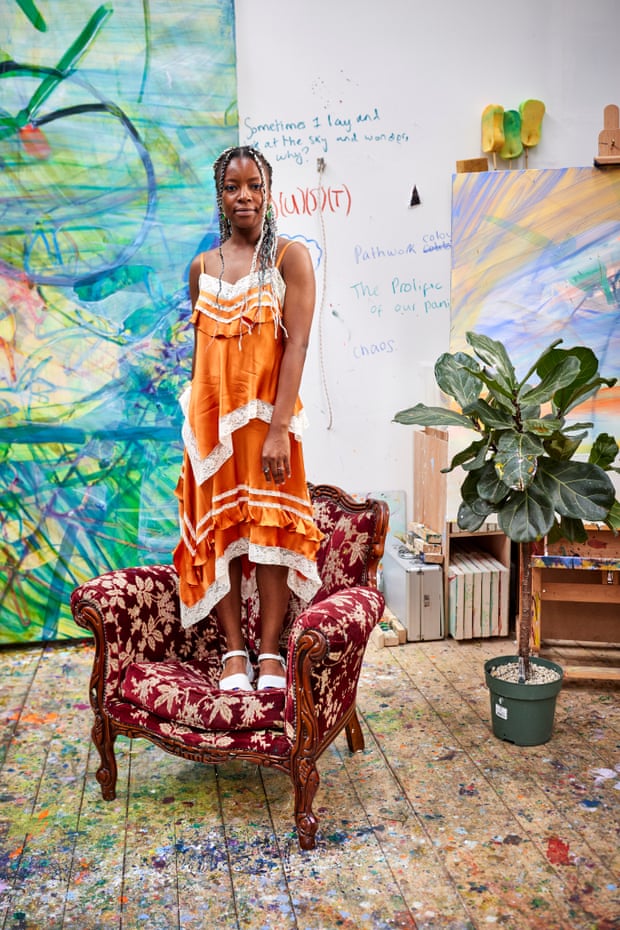
Anime is still the primary influence in Fadojutimi’s paintings, an obsession that has led her to learn Japanese, visit the country several times a year, discoverits artists, such as her all-time favourite Makiko Kudo, go to fan conventions, and do cosplay in Lolita-style garb – a subculture that is, she notes with some understatement, “controversial sometimes. But there was something that was also, for me as a woman, quite feminist about it. It was almost my armour.”
Anime also seemed to have almost nothing to do with her own upbringing as a Black British woman of Nigerian heritage. Yet Fadojutimi is insistent about her right to express herself as she is, rather than have to represent someone else’s idea of Blackness. “There’s been a lot of people look at my work and say it doesn’t look like I’m Black. And I think, ‘Well, question that statement.’ My practice rejects labels and celebrates individuality without contextualising someone into a category.”
That said, she adds, one of the first feelings she tapped into when making paintings at art school was the sense of displacement she experienced from straddling two cultures: “Going outside my home and being British – and going home and being Nigerian.” Her work mines her identity, but race is part of it rather than the defining factor.
The paintings bound for Hepworth Wakefield are inspired by feelings of displacement, too: “Thinking back to that day when it was 40 degrees, and feeling global warming actually happening, I wanted to have a conversation with nature.” She wanted to see whether a painting could express a life force in the same way a tree does, and to explore how healing she found trees during the pandemic. To elaborate, she reads from her diary: “With the world as it is I cry for their souls too. They live with us and yet are they even appreciated? It can be difficult to feel in a world where they burn.”
There were other challenges now expressed in the paintings. Fadojutimi says that the pandemic “changed my mental health”. When she got on her first flight after Covid, she adds, “my body had changed, my brain had changed and yet there was this spirit inside me that was wanting to fight this change”.
Last year, things reached crisis point. “I just wrote a book really quickly one day and forgot to sleep.” She laughs. “And everyone was like, ‘Oh no, something must be wrong.’”
I said, ‘Of course I’m different – how do you think I make these paintings?’
In fact, Fadojutimi had been working for a few nights without sleeping, “because I enjoyed being an artist”. But, presumably worried, doctors stepped in – an intervention still not welcomed by the artist. “Everyone had this fear that I was different, and I was like, ‘Of course I’m different – how do you think I make these paintings?’”
Fadojutimi worries that if she is medicated, she will no longer be able to access the emotions that inspire her work. “I’m neurodiverse, I know that, I have a nice list of characteristics. There’s a lot of people who will tell you that there’s this statistic and that statistic and maybe we should medicate you to stop you ever falling into a statistic and I will fight back saying, ‘I’ve been myself for 29 years, I’m just me. Why are you giving me medicine that means I can’t feel?’ I’d rather drink my green tea and watch my diet. I’d be talking to health professionals in the studio and I’d be crying and saying, ‘Art is therapy too.’” While in hospital once, she says, she was invited to do art therapy. “I’ve watched people in these spaces trapped in that system and I’ve wondered, ‘Is it a healing process or is it a prison?’”
Fadojutimi insists “painting’s always been my saviour” – the way that she makes sense of herself and the world. She says the paintings are her diary, expressing trauma and pain, but also joyful connections with other people, and with nature, which is probably why they resonate so widely, not just with art world people but with young fans. She is often stopped in the street by people who say how much they love her paintings. Scattered around the studio are the materials she’s experimenting with constantly as her work takes rapid strides, from melting trays of pastels to rolls of masking tape. Filled with the colour that sustains her, the studio is the place she feels at home.
One hopes the Gagosian, and all the other people around her, can give her the care she needs. But in relation to her artistic purpose, Fadojutimi is crystal clear. When she thinks about the pandemic and all the suffering it brought, she says: “I think about how privileged I am as an artist to be able to come to the studio and feel like I can breathe. I hope other people can look at my work and feel like they can breathe for a moment too.”

